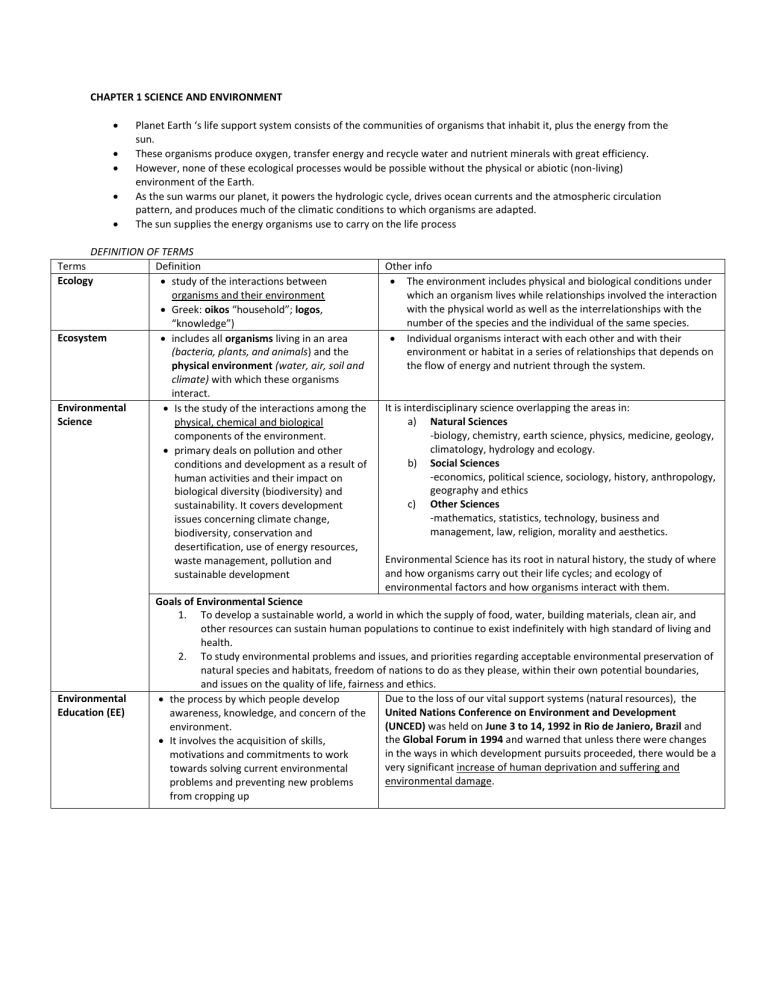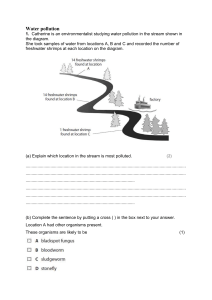
CHAPTER 1 SCIENCE AND ENVIRONMENT Planet Earth ‘s life support system consists of the communities of organisms that inhabit it, plus the energy from the sun. These organisms produce oxygen, transfer energy and recycle water and nutrient minerals with great efficiency. However, none of these ecological processes would be possible without the physical or abiotic (non-living) environment of the Earth. As the sun warms our planet, it powers the hydrologic cycle, drives ocean currents and the atmospheric circulation pattern, and produces much of the climatic conditions to which organisms are adapted. The sun supplies the energy organisms use to carry on the life process DEFINITION OF TERMS Terms Definition Ecology study of the interactions between organisms and their environment Greek: oikos “household”; logos, “knowledge”) Ecosystem includes all organisms living in an area (bacteria, plants, and animals) and the physical environment (water, air, soil and climate) with which these organisms interact. Environmental Is the study of the interactions among the Science physical, chemical and biological components of the environment. primary deals on pollution and other conditions and development as a result of human activities and their impact on biological diversity (biodiversity) and sustainability. It covers development issues concerning climate change, biodiversity, conservation and desertification, use of energy resources, waste management, pollution and sustainable development Environmental Education (EE) Other info The environment includes physical and biological conditions under which an organism lives while relationships involved the interaction with the physical world as well as the interrelationships with the number of the species and the individual of the same species. Individual organisms interact with each other and with their environment or habitat in a series of relationships that depends on the flow of energy and nutrient through the system. It is interdisciplinary science overlapping the areas in: a) Natural Sciences -biology, chemistry, earth science, physics, medicine, geology, climatology, hydrology and ecology. b) Social Sciences -economics, political science, sociology, history, anthropology, geography and ethics c) Other Sciences -mathematics, statistics, technology, business and management, law, religion, morality and aesthetics. Environmental Science has its root in natural history, the study of where and how organisms carry out their life cycles; and ecology of environmental factors and how organisms interact with them. Goals of Environmental Science 1. To develop a sustainable world, a world in which the supply of food, water, building materials, clean air, and other resources can sustain human populations to continue to exist indefinitely with high standard of living and health. 2. To study environmental problems and issues, and priorities regarding acceptable environmental preservation of natural species and habitats, freedom of nations to do as they please, within their own potential boundaries, and issues on the quality of life, fairness and ethics. Due to the loss of our vital support systems (natural resources), the the process by which people develop United Nations Conference on Environment and Development awareness, knowledge, and concern of the (UNCED) was held on June 3 to 14, 1992 in Rio de Janiero, Brazil and environment. the Global Forum in 1994 and warned that unless there were changes It involves the acquisition of skills, in the ways in which development pursuits proceeded, there would be a motivations and commitments to work very significant increase of human deprivation and suffering and towards solving current environmental environmental damage. problems and preventing new problems from cropping up THE ROLE OF ENVIRONMENTAL EDUCATION In the Philippines, the environmental disturbances are experienced air pollutants in the form of gases and chemicals enter the atmosphere and threatened human health. Toxic wastes and industrial effluents flow and contaminate rivers and shorelines. Illegal fishing using chemicals significantly damage our coral reefs. Non-biodegradable materials clogging esteros, canals and other waterways causing severe floods in rural and urban areas. Contamination of oceans due to frequent oil spills is evident. The demand for food, water, energy, housing, transport and other basic necessities continue to escalate. These environmental problems created urgent demands and challenges to the education sector in the country and the whole world. One strategic approach to address these demands and challenges is to incorporate social and environmental issues, concerns and awareness into the curricula in the primary, secondary and collegiate levels in the educational program of the government. There is a timely appeal of environmentalists to the Department of Education to incorporate the “Zero waste” approach in dealing with the day to-day activities of every Filipino in the curricula and extra-curricular activities in the three levels of education in the country. The schools provide the bet venue and training ground to introduce, support, and promote ecological awareness, action and commitment among students. ENVIRONMENTAL EDUCATION AND ITS GOALS 1. Society prepares its citizens to carry out their responsibilities through its system of education. a) Education must develop in each citizen an awareness of, and a sensitivity to the environment and its problems. b) Education must teach each citizen the knowledge, understanding and skills needed to solve problems. c) Education must foster positive attitudes and patterns of conduct toward the environment. 2. 3. 4. 5. 6. Environmental education must consider all aspects of the environment – natural and man-made, technological, social, economic, political, cultural, aesthetic and knowledge. E.E. must emphasize an enduring continuity, linking actions of today to the consequences for tomorrow and the need to think globally. E.E. must aid young citizens in developing a sense of responsibility and commitment to the future, and prepare them to carry out the role of safeguarding and improving the environment upon which al life depends. Real environmental education is far different. It teaches students critical thinking and informs them of environmental science as it really is; an ongoing search for truth. In sum, environmental education is a valuable part of science instruction, that molds students into smug crusaders whose initial foundation of knowledge is shaky at best. TWO WORLD VIEWS CORNUCOPIANISM The dominant world view by Western Civilization throughout most of history. All parts of environment are natural resources to be exploited for the advantage of humans It assumes that resources are infinite. Pollution is a sign of progress Without exploitation of resources, men would still be living a primitive life ENVIRONMENTALISM Natural resources are products of the natural environment. Resources will be limited by the regenerate capacities of the natural environment and that these limited resources will be available if the natural environment is protected, maintained, and sustained. Continuing the trend of increasing exploitation is sustainable only if we do it with limitations SEVEN ENVIRONMENTAL PRINCIPLES 1. Nature Knows Best In the environment, there are processes or cycles that maintained ecological balance. Any disruption in these processes affects the environment. a) Cyclic flow of materials or nutrients in the ecosystem. In nature, nutrient pass from the environment to organism and back to the environment. Ex. Our atmosphere is 78% nitrogen but this cannot be directly assimilated by plants. It has to be converted by plants and used to form plant proteins. When a plant is eaten by an animal, the plant protein is utilized to form animal protein. When the plant and the animal die, the proteins are acted upon by decomposers releasing the nutrients back into the environment to be reused again. Burning of farm wastes instead of allowing them to decompose naturally disrupt the cycle. When farm waste is burned, organic compounds are released into the atmosphere thus, decomposers will not be able to break down immediately resulting in delay in the return of nutrients in the environment. b) Interaction within the food web. This will cause the prey population to increase causing imbalance in the food web. Ex. Excessive deforestation in Mindanao caused by moving away of owls and snakes that prey on rats. This brought an increase in the rat population that destroyed the crops in the farms. 2. All Forms of Life are Important Biological diversity refers to the variety of species in a given community (Species diversity/ Number of species, Genetic diversity/ Variety of genes in the gene pool, & Community diversity/ Number communities in a given area) At the human lever, biological diversity also means cultural diversity- human vary in religion, political beliefs, tradition, language, etc. Disruption of these functions may lead to instability or imbalance. Each individual is a part of the food chain, and the removal of one will upset eating patterns and may cause the extinction of other organisms which feed on it. 3. Everything is Related to Everything Else This principle is best exemplified by the concept of ecosystem. Ecosystem unit of the biosphere in which living and non-living things interact. This definition shows that living and non-living things are interconnected. Industrialization is one process that bring pollution that may affect one’s heath. Vehicle gas emissions and combustions of fossil fuels for industrial processing power plant and factories cause air pollution that increase the incidence of respiratory illness. Households also release raw sewage into bodies of water that pollute the water causing any aquatic organisms to die and causing chronic health problems for people. Conversion of agricultural lands to subdivisions results in reduction in hectarage for food production which results to lower volume or quantity of crop harvest. Also, agricultural land converted to urban and industrial uses account for the growing loss of country’s best soil. 4. Changes Types of Natural Change a) Linear Change (physical and biological evolution) Since the Earth began, is has been undergoing change. From a ball of a dust and gas to its present state with a distinct lithosphere, hydrosphere, from the soupy oceanic bowl of quasi-life molecules to the exuberant diversity that now inhabits the Erath. b) Cyclic Change. The movement of the Earth as an astronomical body results in the occurrence of the seasons, and the days and nights. With this rhythm also occurs rhythms in plants and animal life. c) Random Change The catastrophic forces like volcanic eruption, earthquakes, tsunami, and typhoons. Human activities have impacted on natural system in several ways. a) Change can be accelerated as in siltation of lakes due to rapid soil erosion, eroding of metals because of air pollution and development of cancer cells because of modern chemicals. b) Change can be inhibited - c) the non-complete development of fetuses because of radiation of bird’s egg’s because of DDT in the food chain. Change that is totally different from nature’s cycle can also be introduced such as non-systems like urban communities. Changes that brings about by Human Activities One big change is the population explosion that have been brought about by modern medicine resulting in increased life expectancy and decreased mortality. Another important change in lifestyle has been made possible by new resource consuming technology and is accompanied by materialistic values. These cultural changes have caused significant changes in the natural world such as the destruction of forest, coral reefs and other ecosystems, loss of biodiversity, leveling of mountains due to quarrying, and poisoning of the seas by toxic waste an oil spill. 5. Everything Must go Somewhere It is important that everyone becomes aware of the different types of waste whether they are biodegradable or nonbiodegradable, whether they are hazardous or not. Classification of waste facilities their proper disposal and minimizes if not prevents the entry of toxic waste into the vital ecosystems and ensures reconversion into useful forms. 6. Finiteness of Resources The finiteness of resources can be seen in the following ways: a) Limits to the Earth’s carrying capacity The amount of life the Earth can support) An environmental issue brought about by exceeding the threshold level of an ecosystem is extinction. b) Limits of the Earth’s absorptive capacity The ability to assimilate its waste products A growing population loads to an increasing generation of waste. This is giving more stress on our ecosystems and making them polluted. c) Limits to the Earth’s supply Resources like water are considered renewable but there is still a limit of what it can provide to human living. They are even threatened by pollution, erosion, and over-use. Trees and other plants are renewable resources but are being cut at a rate faster than they can replace them. The Earth’s supply minerals which are nonrenewable present to us very clearly that the Earth’s supply of resources has limits. d) Limits to economic value Some of the things we buy in the market used to be free. Now because of scarcity of food source, they are being sold even air which is still unlimited supply becomes a commodity. One has to spend money to go to a place to breath fresh air. Nations must choose how they are willing to pay to keep the air clean e) f) Limits overtime we decide whether to use a resource today or in future ex, once oil is pumped from the ground and burned as fuel or source of energy it is gone forever. A tree when cut down today cannot be logged in the future, although a sapling can be planted to replace the tree. But at the rate some people are cutting trees in our Philippine forest, they will be gone in 30-35 years. The world’s supply of oil is projected to last for 50 years. Limits to the distribution of resources The Earth’s resources are like a pie. Nations and individuals partake a slice of it. But who consumes most of the resources? The developing world has ¾ of the world’s population but shares in 1/10 of the resource pie. There is a highly unequal distribution of the Erath’s wealth. Industrialized nations have consumed most of their source of raw materials. When supply becomes acute or gone, they crossed oceans and mountains and overcame natural barriers to conquer the world. 7. Nature is Beautiful and We are Stewards of God’s Creation - Humans are the only ones made in God’s image and have been given the right to have dominion over all his creations. - Being the most intelligent and gifted with reasons, humans are capable of manipulating creation to their own advantage. Yet, creation exists not to be ravaged or abused but to be taken care of. Humans cannot exist without nature. They are conatural with the environment they live in.






